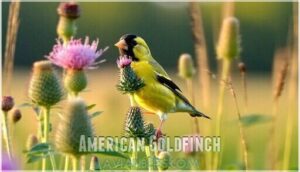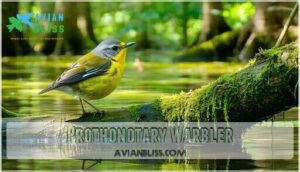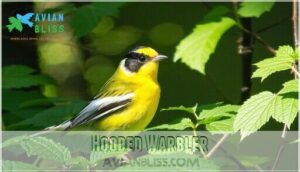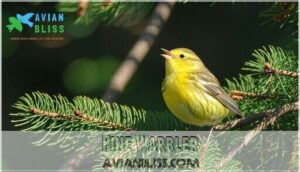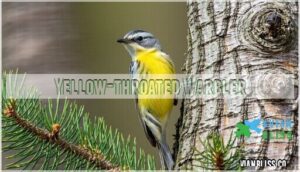This site is supported by our readers. We may earn a commission, at no cost to you, if you purchase through links.
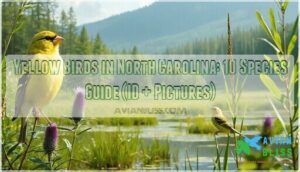 You’ll find ten stunning yellow birds in North Carolina throughout the year, from the bright American Goldfinch at your feeder to secretive warblers in dense forests.
You’ll find ten stunning yellow birds in North Carolina throughout the year, from the bright American Goldfinch at your feeder to secretive warblers in dense forests.
These golden beauties include year-round residents like Pine Warblers and seasonal migrants such as Yellow Warblers that arrive each spring.
They occupy different habitats across the state’s mountains, piedmont, and coast – some preferring treetops while others favor marshes or woodland edges.
Each species has unique field marks, songs, and behaviors that help with identification.
Knowing when and where to look makes all the difference between a fleeting glimpse and a memorable encounter with these feathered gems.
Table Of Contents
- Key Takeaways
- American Goldfinch
- Yellow Warbler
- Yellow-rumped Warbler
- Prothonotary Warbler
- Common Yellowthroat
- Hooded Warbler
- Pine Warbler
- Magnolia Warbler
- Yellow-throated Warbler
- Kentucky Warbler
- Frequently Asked Questions (FAQs)
- Are yellow birds common in North Carolina?
- Are gray catbirds common in North Carolina?
- Where do yellow warblers live in North Carolina?
- Where can I find yellowthroats in NC?
- Where can I find a yellow Meadowlark in North Carolina?
- Do Hirundo birds live in North Carolina?
- How can I attract yellow birds to my backyard feeder?
- What do yellow birds in North Carolina typically eat?
- Are there any rare yellow bird species in North Carolina?
- How do I identify male versus female yellow birds?
- Conclusion
Key Takeaways
- You’ll find American Goldfinches year-round, with males showing brilliant yellow plumage in the breeding season and both sexes turning olive-brown in winter – attract them with nyjer and thistle seeds at your feeders.
- Spring brings migrant warblers like Yellow Warblers and Yellow-throated Warblers, while residents like Pine Warblers stay loyal to pine forests throughout the winter months across the state.
- Each species prefers specific habitats – you’ll spot Common Yellowthroats in marshes, Prothonotary Warblers in wooded swamps, and Hooded Warblers in dense forest undergrowth with different songs and behaviors.
- Timing and location matter for successful sightings – knowing migration patterns, preferred habitats, and seasonal plumage changes helps you distinguish between species and increases your chances of memorable encounters.
American Goldfinch
You’ll spot American Goldfinches year-round in North Carolina, though their appearance changes dramatically with the seasons.
Males flash brilliant yellow plumage with jet-black caps and wings during breeding season, while Winter Plumage transforms both sexes into muted olive-brown birds with darker wings.
Brilliant yellow males transform into muted winter birds—nature’s seasonal costume change.
These energetic members of the Finch Family have specific Seed Preferences that make them easy to attract.
They’re practically dependent on thistle seeds, showing remarkable Thistle Dependence alongside sunflower and nyjer seeds.
You’ll find these yellow finches nc residents in weedy fields, overgrown areas, and backyard feeders.
For successful Backyard Birding, offer nyjer feeders and let native plants like dandelions go to seed.
These yellow birds perform acrobatic feeding displays while clinging to seed heads.
During courtship, males perform undulating flight patterns while singing their distinctive "po-ta-to-chip" call.
Watch for their late nesting season when they build delicate cups using plant down and spider silk in July and August.
Their bouncy flight pattern is also a key identifier.
Yellow Warbler
While American Goldfinches add brilliance to North Carolina’s landscape, you’ll find another stunning yellow bird species that’s equally enchanting.
The Yellow Warbler stands out as one of the most vibrant yellow birds in North Carolina, earning the nickname "American Yellow Warbler" for its entirely golden plumage.
During Migration Patterns from April through September, these warbler species pass through the state’s wetlands and riparian areas.
Males display bright yellow coloring with rusty streaks across their breast, while females show more subdued yellow tones.
Their Identification Tips include listening for their distinctive "sweet-sweet-sweet-I’m-so-sweet" song.
Yellow warblers nc populations prefer Habitat Preference areas near water sources, including stream edges and marshy thickets.
They’ve a melodious, sweet song.
Their Breeding Habits involve constructing cup-shaped nests in shrubs and small trees.
Though their Conservation Status remains stable, habitat preservation proves vital for these neotropical migrants.
You’ll spot them foraging for insects among willow branches and cattails throughout their journey.
Yellow-rumped Warbler
The yellow-rumped warbler‘s distinctive golden rump patch makes identification easy among nc birds.
You’ll spot this hardy warbler species hopping through trees, displaying remarkable cold tolerance compared to other north carolina birds.
The Myrtle subspecies dominates eastern regions with gray-brown upperparts and white wing bars.
During breeding season, males show bold black streaking across white breasts, while winter plumage becomes duller brown overall.
These yellow-rumped warbler champions migrate up to 3,000 miles, arriving earlier in spring than most yellow birds.
Their migration patterns bring millions through North Carolina annually.
Watch for their unique feeding behavior—they’ll catch insects during summer but switch to waxy bayberries in winter.
This habitat preference adaptation lets them survive northern winters when other warblers head south.
Listen for their distinctive buzzy trill echoing through pine forests and streamside thickets.
They’re classified as Setophaga coronata.
Prothonotary Warbler
Looking at wetland areas throughout North Carolina, you’ll discover the prothonotary warbler’s vibrant golden-yellow plumage makes it unmistakable among nc birds.
This species stands out with its bright yellow head and underparts contrasting beautifully with blue-gray wings and back.
Habitat Preference centers on wooded swamps, bottomland forests, and stream corridors where water meets trees.
These yellow birds favor areas with standing water and mature trees for their unique Nesting Habits – they’re cavity nesters, using old woodpecker holes or nest boxes positioned over water.
Diet consists primarily of insects, caterpillars, and spiders gleaned from bark and foliage.
During migration, they’ll supplement with fruits and seeds.
Vocalizations include a loud, ringing "sweet-sweet-sweet" song that carries across wetlands.
Males sing persistently during breeding season to establish territory.
Conservation Status remains stable, though wetland habitat loss poses ongoing challenges.
They’re known for energetic foraging behavior, flitting between branches in search of insects.
Protecting riparian corridors benefits this species substantially, making proper yellow bird identification important for conservation efforts supporting north carolina birds.
Common Yellowthroat
After admiring the Prothonotary Warbler, you’ll want to keep an eye out for the Common Yellowthroat. This tiny yellow bird is easy to recognize by the male’s Distinctive Mask—a bold black band across his face, bordered by white.
You’ll often hear its sharp whit-ti-tee song before spotting it skulking through dense, low plants. The Common Yellowthroat’s Habitat Preference includes marshes, thickets, and wetland edges across North Carolina.
Watch for their unique Nesting Habits: they build cup-shaped nests low in tangled vegetation. Their Vocalizations are loud for such a small bird.
Though their Conservation Status is currently stable, habitat loss remains a threat. These North Carolina birds bring a splash of color and energy to any outing. The Common Yellowthroat’s insectivorous diet and foraging habits play a vital role in its survival and adaptation to different environments.
Hooded Warbler
Out among the tangled vines and thick shrubs, you might spot the Hooded Warbler—a true gem for any north carolina birds enthusiast. This yellow bird stands out with its lemon-yellow face and bold black hood, making bird identification a breeze.
If you’re lucky, you’ll catch its sharp “weeta-weeta-weet-tee-o” song echoing through the forest. Hooded Warblers are specialists, thriving in mature forests with dense undergrowth. They’re known to use white tail feathers to startle insects.
- Striking black-hooded males flash through the shadows
- Builds cup-shaped nests low in shrubs, a marvel of nesting behavior
- Feeds on insects, often flicking its tail to flush out prey
- Prefers rich, moist woods—classic habitat preferences for warblers
- Conservation status is stable, but habitat loss and nest parasites pose threats
Watch for their migration patterns each spring—these yellow birds are a highlight in any bird identification guide.
Pine Warbler
After spotting a Hooded Warbler, you might notice a Pine Warbler singing its steady trill high in a pine.
This yellow bird species is a classic among north carolina birds, sticking to pine forests year-round. Its Habitat Preference is so strong, you’ll rarely find it outside pine trees.
For bird identification, look for yellow plumage, white wing bars, and that “broken wheel” Song Identification.
Nesting Habits include building nests high in pines with needles and grasses.
In winter, Pine Warblers join mixed flocks. Their Conservation Status is stable—these yellow birds thrive where pine trees grow, making them a reliable sight.
Magnolia Warbler
If you’re hoping to add a splash of color to your birdwatching list, the Magnolia Warbler is a real showstopper among yellow birds in North Carolina.
This small warbler is easy to spot thanks to its bold black streaks on a yellow breast, crisp white wing bars, and a black “necklace” that makes identification a breeze.
Magnolia Warblers prefer dense, young coniferous forests—look for them in spruce and hemlock stands during spring and summer.
Their energetic foraging and acrobatic moves are fun to watch as they search for insects.
Breeding habits center on northern woodlands, while migration patterns take them from Central America up to the Appalachians.
Their conservation status is stable, thanks to adaptability and healthy second-growth habitats.
Similar to the Chestnut-Sided Warbler, they undertake long-distance travel during migration.
Yellow-throated Warbler
If you’re wandering through North Carolina’s forests, keep an eye out for the Yellow-throated Warbler—one of the state’s most striking yellow birds.
Its plumage variations are hard to miss: a bold yellow throat, gray upperparts, and crisp white underparts, plus a sharp black triangle below the eye.
You’ll often spot this warbler high in pine trees, creeping along branches and probing bark for insects—a foraging behavior that’s almost acrobatic.
Yellow-throated Warblers favor wetland forests and cypress swamps, but they’ll also show up in dry upland pine woods.
Listen for their buzzy vocalizations echoing through the canopy.
In the context of nesting habits, both parents pitch in, building open cup nests from plant fibers and spiderwebs.
For bird watching NC enthusiasts, this warbler adds a splash of sunshine to any woodland walk.
They share similar habitat preferences with the black throated gray warbler.
Kentucky Warbler
Discovering Kentucky Warblers in North Carolina’s woodlands feels like finding hidden treasure.
These stunning yellow birds prefer mature forests with thick understory vegetation.
Habitat preferences: You’ll find them in moist deciduous forests exceeding 1,200 acres, particularly near streams with dense ground cover.
Identification challenges: Look for their distinctive black facial mask with yellow "spectacles" – females show reduced markings compared to males.
Diet specifics: They scratch through leaf litter hunting insects, spiders, and caterpillars with remarkable energy.
Conservation status: With declining populations, protecting large forest tracts remains essential for Kentucky Warbler survival in North Carolina’s bird watching communities.
Their conservation contrasts with the success of the Kirtland’s Warbler recovery.
Frequently Asked Questions (FAQs)
Are yellow birds common in North Carolina?
Yes, you’ll find yellow birds are quite common in North Carolina.
The state hosts numerous yellow species year-round and seasonally, including American Goldfinches, Yellow Warblers, and Yellow-rumped Warblers throughout various habitats.
Are gray catbirds common in North Carolina?
Gray catbirds are quite common throughout North Carolina.
You’ll find these gray songbirds with their distinctive "meow" calls in dense shrubs, forest edges, and thickets across the state year-round, making them a regular backyard visitor.
They are found in these areas year-round.
Where do yellow warblers live in North Carolina?
You’ll find yellow warblers throughout North Carolina’s moist forests, willow groves, and areas with small trees.
They prefer forest edges, shrubs, and woodland areas near water sources during their breeding season from spring through summer, which includes areas with small trees.
Where can I find yellowthroats in NC?
You’ll spot Common Yellowthroats in North Carolina’s marshes, swamps, wet thickets, and overgrown fields. They’re year-round residents in eastern NC and breed statewide during spring and summer months.
Where can I find a yellow Meadowlark in North Carolina?
Eastern Meadowlarks inhabit roughly 60% of North Carolina’s grasslands year-round.
You’ll spot these yellow-breasted beauties foraging on the ground in weedy fields, orchards, farm areas, and backyards throughout the state, with peak numbers during winter months.
Do Hirundo birds live in North Carolina?
You’ll see beautiful Barn Swallows, which belong to the Hirundo genus, in North Carolina. These graceful birds dart over fields and open water hunting insects with their distinctively forked tails.
How can I attract yellow birds to my backyard feeder?
You’ll attract goldfinches, warblers, and other yellow birds by offering nyjer seeds, sunflower hearts, and suet.
Place feeders near shrubs for cover and add native plants like coneflowers for natural food sources, which will help attract birds with natural food sources.
What do yellow birds in North Carolina typically eat?
Absolutely ravenous yellow birds feast on countless seeds, insects, nectar, and berries. You’ll find goldfinches devouring thistle seeds, warblers hunting caterpillars, and orioles sipping sweet nectar from your feeders daily.
Are there any rare yellow bird species in North Carolina?
Yes, you’ll find several rare yellow bird species in North Carolina.
The Painted Bunting female appears as a rare summer visitor in southern areas, while the Scarlet and Summer Tanager females are uncommon migrants passing through during spring and fall seasons.
How do I identify male versus female yellow birds?
Males typically show brighter, more vivid yellow coloring with distinct black markings like caps or wings. Females display duller, paler yellow tones with less contrast and fewer bold features.
Conclusion
Throughout North Carolina’s diverse landscapes, these ten yellow birds in North Carolina paint the state with golden hues year-round.
You’ll discover each species has its perfect timing and habitat preferences.
Spring brings migrant warblers while residents like Pine Warblers stay loyal through winter months.
Your patience and keen observation skills will reward you with unforgettable sightings.
Whether you’re scanning treetops for Yellow-throated Warblers or listening for Common Yellowthroats in marshes, these feathered treasures await your discovery across the Tar Heel State.
- https://birdsoftheworld.org/bow/species/yelwar/1.0/introduction?printable
- https://www.nwcouncil.org/sites/default/files/Vol._III_Ch._16__Yellow_Warbler.pdf
- https://theworldsrarestbirds.com/birds/yellow-birds-in-north-carolina/
- https://sora.unm.edu/sites/default/files/journals/wilson/v090n04/p0566-p0574.pdf
- https://myzootopia.com/articles/exploring-north-american-bird-species/

